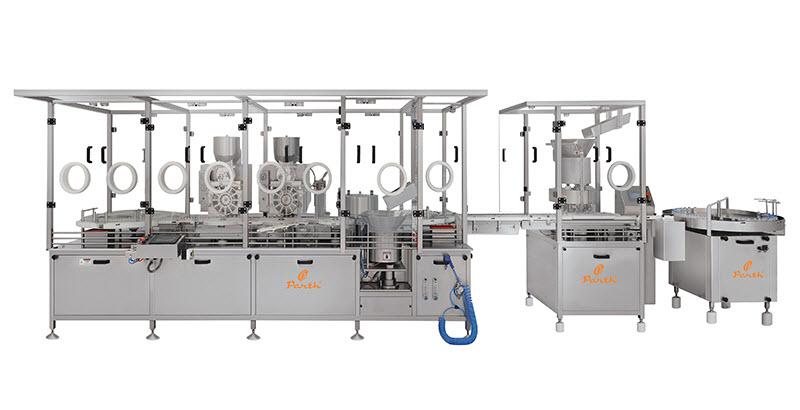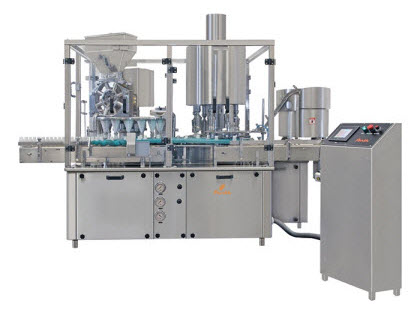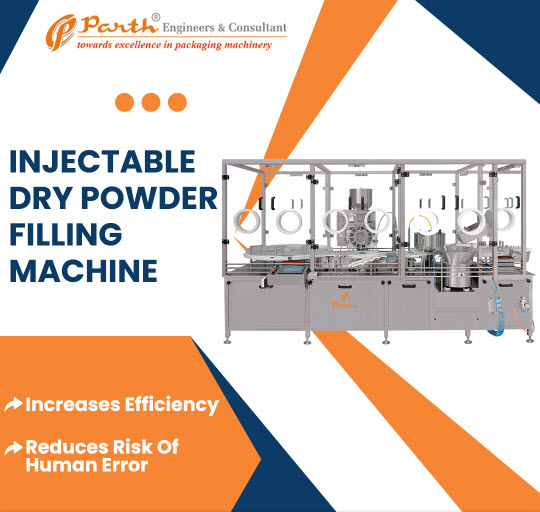For Export Enquiry
Call Us
How Powder Filling Machines Ensure Precise Dosing
Listen to the Audio Version
Powder filling machines play a critical role in industries such as pharmaceuticals, food processing, and cosmetics by ensuring the precise dosing of powdered substances. Accurate dosing is essential for maintaining product quality, consistency, and compliance with industry regulations. These machines are designed to handle a variety of powder types, from free-flowing to non-free-flowing, and are capable of filling containers with exact amounts of product. The precision provided by these machines not only reduces waste but also enhances production efficiency.
By automating the filling process, manufacturers can achieve higher throughput and maintain stringent quality control standards. The technology behind powder filling machines continues to evolve, incorporating advanced features such as programmable logic controllers (PLCs) and real-time monitoring systems. These innovations help manufacturers achieve the high levels of accuracy required in today's competitive market.
Injectable Powder Filling Machine
The injectable powder filling machine is specifically designed for the pharmaceutical industry, where the precise dosing of injectable powders is crucial. These machines ensure that each vial or container is filled with the exact amount of powder needed for accurate dosing in medical treatments. Key features of these machines include sterile filling environments, precise dosing mechanisms, and integration with other pharmaceutical manufacturing processes. The use of these machines helps prevent dosage errors, which can have serious implications for patient safety.

Additionally, the sterile environment maintained during the filling process reduces the risk of contamination, ensuring the safety and efficacy of the injectable products. Manufacturers benefit from the efficiency and reliability of injectable powder filling machines, as they help streamline production and maintain high standards of quality control. With the increasing demand for injectable medications, the role of these machines in the pharmaceutical industry is becoming more significant.
Dry Syrup Powder Filling Machine

Dry syrup powder filling machines are essential in the pharmaceutical industry for accurately dosing powdered medications that are reconstituted with liquid before use. These machines ensure that each bottle contains the correct amount of dry syrup powder, maintaining consistency and efficacy in medical treatments. They are equipped with advanced features like auger filling mechanisms and precise control systems to handle the specific requirements of dry syrups. The ability to accurately fill containers with dry syrup powder is critical for patient safety and effective treatment outcomes.
By automating the filling process, these machines reduce the risk of human error and contamination, which are common concerns in pharmaceutical manufacturing. Manufacturers benefit from the increased efficiency and productivity provided by dry syrup powder filling machines, as they can handle high volumes of production with consistent accuracy. The integration of these machines into the production line ensures that pharmaceutical companies can meet stringent regulatory requirements and maintain the highest standards of quality.
Powder Filling Line
A powder filling line is a comprehensive system that integrates various machines and components to automate the filling of powders into containers. This setup includes hoppers, conveyors, filling machines, and sealing equipment, all working together to ensure precise dosing and efficient production. The integration of these components streamlines the entire filling process, from loading the powder into the hopper to sealing the filled containers. This system is designed to handle large production volumes, making it ideal for industries such as pharmaceuticals, food processing, and cosmetics.
The powder filling line ensures consistency in the amount of powder dispensed into each container, which is crucial for maintaining product quality and meeting regulatory standards. By automating the filling process, manufacturers can achieve higher throughput, reduce labour costs, and minimise the risk of human error. The versatility of powder filling lines allows them to accommodate different types of powders and container sizes, providing flexibility for various production needs.
Injectable Dry Powder Filling Machine
The injectable dry powder filling machine is an advanced piece of equipment designed for the precise dosing of dry powders into vials for injectable medications. This machine is crucial in the pharmaceutical industry, where accuracy and sterility are paramount. It features a closed filling environment to maintain sterility and prevent contamination, ensuring that the medications produced are safe for patient use. The machine uses sophisticated dosing mechanisms to measure and dispense the exact amount of powder required for each vial. This precision is essential for ensuring the correct dosage and efficacy of the medication.
The injectable dry powder filling machine is capable of handling high production volumes, making it suitable for large-scale pharmaceutical manufacturing. Its integration with other sterile processing equipment ensures a seamless and efficient production line. By automating the filling process, this machine helps pharmaceutical companies meet stringent regulatory requirements and maintain high standards of quality control.
Dry Syrup Powder Filling Line
The dry syrup powder filling line is a specialised system designed to fill bottles with precise amounts of dry syrup powder, which is later reconstituted with liquid. This line includes various components such as hoppers, auger fillers, conveyors, and capping machines, all working together to ensure accurate and efficient filling. The system is designed to handle the specific characteristics of dry syrup powders, such as their flow properties and sensitivity to moisture.
By automating the filling process, the dry syrup powder filling line reduces the risk of contamination and human error, ensuring consistent product quality. The integration of advanced control systems allows for real-time monitoring and adjustments, ensuring that each bottle is filled with the correct amount of powder. This precision is crucial for maintaining the efficacy of the medication and ensuring patient safety. The dry syrup powder filling line is an essential component in pharmaceutical manufacturing, helping companies meet regulatory requirements and maintain high standards of production.
Volumetric Filling
Volumetric filling machine is a widely used technique in powder filling machines, where a predefined volume of powder is measured and dispensed into each container. This method ensures consistent dosing by relying on the volume of the product rather than its weight. Volumetric filling machines are equipped with adjustable measuring chambers or cylinders that can be customised to dispense specific volumes of powder. This technique is particularly effective for free-flowing powders, as it provides a simple and reliable method for achieving precise doses.
One of the main advantages of volumetric filling is its speed, making it suitable for high-volume production environments. However, it may not be as accurate for powders with varying densities or flow characteristics. To address this, some volumetric filling machines are integrated with advanced sensors and control systems that adjust the volume based on real-time feedback. This enhances the overall accuracy and reliability of the filling process, ensuring that each container receives the correct amount of powder.
Gravimetric Filling
Gravimetric filling is a highly accurate method used in powder filling machines, where the amount of powder dispensed is measured by weight rather than volume. This technique involves the use of precise weighing systems that ensure each container is filled with the exact weight of powder required. Gravimetric filling is particularly beneficial for products where weight accuracy is critical, such as pharmaceuticals and high-value powders. The machine is equipped with sensitive scales and load cells that provide real-time weight measurements during the filling process.
This allows for continuous adjustments to ensure consistent dosing. The high level of precision offered by gravimetric filling reduces waste and ensures that each product meets stringent quality standards. While this method may be slower than volumetric filling due to the weighing process, it offers unparalleled accuracy and is ideal for applications where precise dosing is essential. By integrating gravimetric filling technology, manufacturers can achieve the highest levels of accuracy and consistency in their production processes.
Auger Filling Technology
Auger filling technology is a common method used in powder filling machines, where a rotating screw or auger is used to dispense precise amounts of powder into containers. This technique is particularly effective for handling both free-flowing and non-free-flowing powders. The auger is driven by a motor, and its rotation rate can be adjusted to control the amount of powder dispensed. The precise control offered by auger filling machines ensures consistent dosing, which is crucial for maintaining product quality.
Auger fillers are equipped with sensors and feedback systems that monitor the filling process and make real-time adjustments to ensure accuracy. This technology is widely used in various industries, including pharmaceuticals, food processing, and cosmetics. One of the key advantages of auger filling is its versatility, as it can handle a wide range of powder types and container sizes. By automating the filling process, auger filling machines enhance production efficiency and reduce the risk of human error, ensuring consistent and reliable dosing.
Programmable Logic Controllers (PLCs)
Programmable Logic Controllers (PLCs) play a crucial role in enhancing the precision and efficiency of powder filling machines. These advanced control systems allow for the automation of the filling process, providing operators with the ability to set and adjust dosing parameters easily. PLCs are equipped with user-friendly interfaces, such as touchscreens, that enable real-time monitoring and control of the machine's operations. This technology ensures that the filling process is consistent and accurate, reducing the risk of human error.
By integrating PLCs, powder filling machines can achieve higher levels of precision, as the controllers can make continuous adjustments based on real-time data. This capability is particularly important in industries such as pharmaceuticals, where precise dosing is critical for product quality and compliance with regulatory standards. The use of PLCs also enhances the flexibility of powder filling machines, allowing them to be easily reconfigured for different products and production requirements. Overall, the integration of PLCs in powder filling machines significantly improves their performance and reliability.
Real-Time Monitoring and Adjustments
Real-time monitoring and adjustments are essential features of modern powder filling machines, ensuring high levels of precision and consistency in the filling process. These machines are equipped with advanced sensors and feedback systems that continuously monitor various parameters, such as the weight and volume of powder being dispensed. By providing real-time data, these systems enable the machine to make immediate adjustments to maintain accurate dosing. This capability is crucial for industries where precise dosing is essential, such as pharmaceuticals and food processing.
Real-time monitoring helps identify any discrepancies or issues during the filling process, allowing for quick corrective actions to be taken. This not only ensures product quality but also reduces waste and minimises downtime. The ability to make real-time adjustments enhances the overall efficiency and reliability of powder filling machines. Manufacturers benefit from the improved accuracy and consistency provided by these advanced monitoring systems, which help maintain high standards of production and compliance with industry regulations.
Interchangeable Filling Heads
Interchangeable filling heads are a key feature of versatile powder filling machines, allowing them to handle a wide range of powder types and container sizes. These machines are designed with modular components that can be easily swapped out to accommodate different filling requirements. This flexibility is particularly beneficial for manufacturers who produce multiple products or need to switch between different powders. By using interchangeable filling heads, manufacturers can ensure precise dosing for various products without the need for multiple machines.
This feature enhances the efficiency and cost-effectiveness of the production process, as it reduces the need for extensive reconfiguration or additional equipment. Interchangeable filling heads also allow for easy maintenance and cleaning, ensuring that the machine remains in optimal condition. The ability to adapt to different products and production needs makes powder filling machines with interchangeable filling heads a valuable asset for industries such as pharmaceuticals, food processing, and cosmetics.
Hopper Design
The design of the hopper in powder filling machines plays a crucial role in ensuring precise dosing. The hopper is responsible for holding and feeding the powder into the filling mechanism, and its design can significantly impact the flow and consistency of the powder. A well-designed hopper ensures that the powder flows smoothly and evenly into the filling machine, reducing the risk of blockages or uneven dosing. Key design considerations include the shape and size of the hopper, as well as the use of agitation or vibration mechanisms to prevent powder from sticking or clumping.
The hopper's material and construction also need to be compatible with the specific powder being used, ensuring that it does not react or contaminate the product. By optimising the hopper design, manufacturers can enhance the accuracy and efficiency of the powder filling process, ensuring consistent and precise dosing. This is particularly important for industries such as pharmaceuticals and food processing, where product quality and safety are paramount.
Nozzle and Discharge Systems
The nozzle and discharge systems in powder filling machines are critical components that directly impact the precision and efficiency of the filling process. These systems are responsible for accurately dispensing the powder into containers, ensuring that each dose meets the required specifications. Different types of nozzles and discharge mechanisms are used depending on the characteristics of the powder and the container being filled. For instance, specialised nozzles are designed to handle fine, free-flowing powders, while others are suitable for more cohesive or granular substances.
The design and material of the nozzles must ensure smooth and consistent flow, preventing blockages and reducing waste. Additionally, advanced discharge systems incorporate sensors and feedback mechanisms that monitor the flow and adjust the dispensing rate in real-time. This ensures that each container receives the exact amount of powder needed, maintaining high levels of accuracy and consistency. By optimising the nozzle and discharge systems, manufacturers can achieve efficient and precise dosing, essential for maintaining product quality and meeting regulatory standards.
Rotary Dry Syrup Powder Filling Machine
The rotary dry syrup powder filling machine is designed to enhance the efficiency and precision of the powder filling process, particularly for dry syrups used in the pharmaceutical industry. This machine features a rotating table that holds multiple containers, allowing for continuous and high-speed filling operations. The rotary mechanism ensures that each container is accurately positioned under the filling head, which dispenses the precise amount of powder needed. This design minimises downtime and maximises production throughput, making it ideal for large-scale manufacturing.
The machine is equipped with advanced control systems that monitor and adjust the filling process in real-time, ensuring consistent dosing. Additionally, the rotary dry syrup powder filling machine is designed to handle the specific properties of dry syrups, such as their flow characteristics and sensitivity to moisture.
By maintaining a controlled and sterile environment, the machine helps prevent contamination and ensures the safety and efficacy of the product. Overall, the rotary dry syrup powder filling machine significantly improves the efficiency and accuracy of the powder filling process, essential for maintaining high standards in pharmaceutical manufacturing.
Pharmaceutical Powder Filling Machine
Pharmaceutical powder filling machines are specially designed to meet the stringent requirements of the pharmaceutical industry, where precise dosing and contamination prevention are critical. These machines are equipped with advanced technologies to ensure accurate and consistent filling of powdered medications into various types of containers, such as vials, bottles, and sachets. Key features of pharmaceutical powder filling machines include sterile filling environments, precise dosing mechanisms, and integration with other pharmaceutical manufacturing processes. The use of these machines helps prevent dosage errors and maintains the integrity of the medications, ensuring patient safety and efficacy.
Pharmaceutical powder filling machines are capable of handling a wide range of powder types, from fine powders to granular substances, and can accommodate different container sizes and shapes. By automating the filling process, these machines enhance production efficiency and reduce the risk of human error. The integration of advanced control systems allows for real-time monitoring and adjustments, ensuring consistent and accurate dosing. Overall, pharmaceutical powder filling machines are essential for maintaining high standards of quality and compliance in the pharmaceutical industry.
Dry Powder Injection Filling Machine
The dry powder injection filling machine is an essential piece of equipment in the pharmaceutical industry, specifically designed for the precise dosing of dry powders into vials for injectable medications. This machine operates in a sterile environment to ensure the safety and efficacy of the injectable products. The precise dosing mechanism of the dry powder injection filling machine ensures that each vial contains the exact amount of powder required for accurate and effective treatment. The machine is equipped with advanced control systems that monitor the filling process and make real-time adjustments to maintain accuracy.
The sterile environment maintained during the filling process reduces the risk of contamination, which is crucial for patient safety. The dry powder injection filling machine is capable of handling high production volumes, making it suitable for large-scale pharmaceutical manufacturing. By automating the filling process, this machine helps pharmaceutical companies meet stringent regulatory requirements and maintain high standards of quality control. The integration of this machine into the production line ensures efficient and reliable dosing, essential for the production of safe and effective injectable medications.
Dry Powder Filling Machine for Pharmaceutical
The dry powder filling machine for pharmaceutical applications is specifically designed to handle the unique requirements of filling powdered medications into various types of containers. These machines are equipped with advanced features to ensure precise and consistent dosing, which is critical for maintaining the efficacy and safety of pharmaceutical products. The dry powder filling machine operates in a sterile environment to prevent contamination and ensure the integrity of the medications. It is capable of handling a wide range of powder types, from fine powders to granular substances, and can accommodate different container sizes and shapes.
The machine uses sophisticated dosing mechanisms, such as auger fillers and volumetric or gravimetric filling systems, to achieve accurate dosing. Real-time monitoring and control systems allow for continuous adjustments to maintain precision throughout the filling process. The automation provided by dry powder filling machines enhances production efficiency and reduces the risk of human error. By integrating these machines into their production lines, pharmaceutical companies can meet stringent regulatory requirements and maintain high standards of quality and consistency in their products.

Vial Powder Filling Machine
Vial powder filling machines are essential in the pharmaceutical industry for accurately filling vials with powdered medications. These machines ensure that each vial contains the precise amount of powder required for effective and safe medical treatments. Key features of vial powder filling machines include sterile filling environments, advanced dosing mechanisms, and integration with other pharmaceutical processing equipment. The sterile environment maintained during the filling process reduces the risk of contamination, ensuring the safety and efficacy of the medications.
Vial powder filling machines use sophisticated technologies such as auger fillers, volumetric, and gravimetric systems to achieve precise dosing. Real-time monitoring and control systems enable continuous adjustments to maintain accuracy and consistency. The ability to handle a wide range of powder types and vial sizes makes these machines versatile and adaptable to different pharmaceutical applications. By automating the filling process, vial powder filling machines enhance production efficiency, reduce labour costs, and minimise the risk of human error. Pharmaceutical companies benefit from the reliable and accurate dosing provided by these machines, which help maintain high standards of quality and compliance with regulatory requirements.
Rotary Powder Filling Machine
Rotary powder filling machines are designed to enhance the efficiency and precision of the powder filling process, particularly in high-volume production environments. These machines feature a rotating table that holds multiple containers, allowing for continuous and high-speed filling operations. The rotary mechanism ensures that each container is accurately positioned under the filling head, which dispenses the precise amount of powder needed. This design minimises downtime and maximises production throughput, making it ideal for large-scale manufacturing.
Rotary powder filling machines are equipped with advanced control systems that monitor and adjust the filling process in real-time, ensuring consistent dosing. The versatility of these machines allows them to handle a wide range of powder types and container sizes, providing flexibility for various production needs. By automating the filling process, rotary powder filling machines enhance production efficiency and reduce the risk of human error. The integration of these machines into the production line ensures that manufacturers can achieve high levels of accuracy and consistency, essential for maintaining product quality and meeting regulatory standards.
Regular Maintenance
Regular maintenance of powder filling machines is essential to ensure their optimal performance and longevity. Routine checks and servicing help identify and resolve potential issues before they lead to significant problems, reducing the risk of downtime and maintaining the accuracy of the filling process. Key maintenance tasks include cleaning the machine components, inspecting and replacing worn parts, and calibrating the dosing mechanisms. Regular lubrication of moving parts is also crucial to prevent wear and tear and ensure smooth operation. In addition to these routine tasks, periodic professional servicing may be required to address more complex issues and perform thorough inspections.
Manufacturers should follow the maintenance schedule recommended by the machine's manufacturer and keep detailed records of all maintenance activities. By adhering to a regular maintenance programme, manufacturers can enhance the reliability and efficiency of their powder filling machines, ensuring consistent and precise dosing. Proper maintenance also helps extend the lifespan of the equipment, providing long-term cost savings and reducing the need for costly repairs or replacements.
Conclusion
Powder filling machines are indispensable in various industries, ensuring the precise dosing and efficient production of powdered products. From pharmaceutical and food processing to cosmetics, these machines enhance product quality, consistency, and compliance with industry regulations. The integration of advanced technologies such as programmable logic controllers (PLCs), real-time monitoring systems, and interchangeable filling heads further improves the accuracy and versatility of powder filling machines.
FAQs - Powder Filling Machines
Powder filling machines can handle a wide range of powder types, including free-flowing and non-free-flowing powders. This includes fine powders, granulated powders, and even cohesive substances.
Powder filling machines use advanced technologies such as auger fillers, volumetric and gravimetric filling systems, and real-time monitoring to ensure accurate and consistent dosing. These systems measure and dispense the exact amount of powder required for each container.
The benefits include enhanced production efficiency, reduced waste, improved product consistency, and compliance with industry regulations. Automation also reduces the risk of human error and contamination.
Injectable powder filling machines are designed for sterile environments, ensuring precise dosing of injectable powders into vials. They use sophisticated dosing mechanisms and sterile processing to maintain product safety and efficacy.
Key features include auger filling mechanisms, advanced control systems for accurate dosing, and components designed to handle the specific properties of dry syrup powders, such as their flow characteristics and sensitivity to moisture.
Yes, many powder filling machines offer interchangeable filling heads and modular components that allow customization for various powder types and container sizes, providing flexibility for different production needs.
PLCs automate the filling process, allowing operators to set and adjust dosing parameters easily. They provide real-time monitoring and control, ensuring consistent and accurate filling, and reducing the risk of human error.
Real-time monitoring systems continuously check various parameters, such as weight and volume, and make immediate adjustments to maintain precise dosing. This helps ensure product quality, reduce waste, and minimize downtime.
A well-designed hopper ensures smooth and even flow of powder into the filling machine, reducing the risk of blockages or uneven dosing. Proper design includes shape, size, and mechanisms to prevent powder from sticking or clumping.
Regular maintenance includes cleaning machine components, inspecting and replacing worn parts, calibrating dosing mechanisms, and lubricating moving parts. Periodic professional servicing is also recommended to address complex issues and ensure optimal performance.
Rotary powder filling machines feature a rotating table that holds multiple containers, allowing for continuous and high-speed filling operations. This design maximizes production throughput and ensures accurate positioning of containers for precise dosing.
Volumetric filling measures and dispenses powder based on volume, making it suitable for free-flowing powders and high-speed production. Gravimetric filling measures powder by weight, providing higher accuracy, especially for products with varying densities.
About Author
We provide 24 x 7 Customer
Service & Support
Copyright © 2025, Parth Engineering & Consultant ( India ).
Web Design by Opal Infotech









